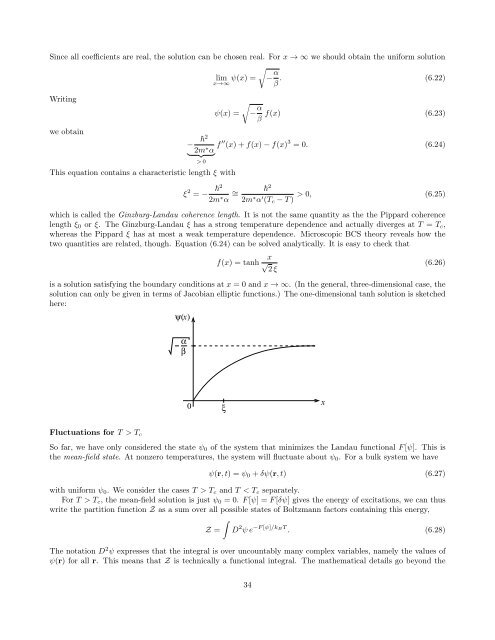Carsten Timm: Theory of superconductivity
Carsten Timm: Theory of superconductivity
Carsten Timm: Theory of superconductivity
You also want an ePaper? Increase the reach of your titles
YUMPU automatically turns print PDFs into web optimized ePapers that Google loves.
Since all coefficients are real, the solution can be chosen real. For x → ∞ we should obtain the uniform solution<br />
√<br />
lim ψ(x) = − α<br />
x→∞ β . (6.22)<br />
Writing<br />
ψ(x) =<br />
√<br />
− α f(x) (6.23)<br />
β<br />
we obtain<br />
This equation contains a characteristic length ξ with<br />
2<br />
−<br />
2m ∗ f ′′ (x) + f(x) − f(x) 3 = 0. (6.24)<br />
} {{<br />
α<br />
}<br />
> 0<br />
ξ 2 = −<br />
2<br />
2m ∗ α ∼ 2<br />
=<br />
2m ∗ α ′ > 0, (6.25)<br />
(T c − T )<br />
which is called the Ginzburg-Landau coherence length. It is not the same quantity as the the Pippard coherence<br />
length ξ 0 or ξ. The Ginzburg-Landau ξ has a strong temperature dependence and actually diverges at T = T c ,<br />
whereas the Pippard ξ has at most a weak temperature dependence. Microscopic BCS theory reveals how the<br />
two quantities are related, though. Equation (6.24) can be solved analytically. It is easy to check that<br />
f(x) = tanh<br />
x √<br />
2 ξ<br />
(6.26)<br />
is a solution satisfying the boundary conditions at x = 0 and x → ∞. (In the general, three-dimensional case, the<br />
solution can only be given in terms <strong>of</strong> Jacobian elliptic functions.) The one-dimensional tanh solution is sketched<br />
here:<br />
ψ(x)<br />
α<br />
β<br />
0 ξ<br />
x<br />
Fluctuations for T > T c<br />
So far, we have only considered the state ψ 0 <strong>of</strong> the system that minimizes the Landau functional F [ψ]. This is<br />
the mean-field state. At nonzero temperatures, the system will fluctuate about ψ 0 . For a bulk system we have<br />
ψ(r, t) = ψ 0 + δψ(r, t) (6.27)<br />
with uniform ψ 0 . We consider the cases T > T c and T < T c separately.<br />
For T > T c , the mean-field solution is just ψ 0 = 0. F [ψ] = F [δψ] gives the energy <strong>of</strong> excitations, we can thus<br />
write the partition function Z as a sum over all possible states <strong>of</strong> Boltzmann factors containing this energy,<br />
∫<br />
Z = D 2 ψ e −F [ψ]/kBT . (6.28)<br />
The notation D 2 ψ expresses that the integral is over uncountably many complex variables, namely the values <strong>of</strong><br />
ψ(r) for all r. This means that Z is technically a functional integral. The mathematical details go beyond the<br />
34

















